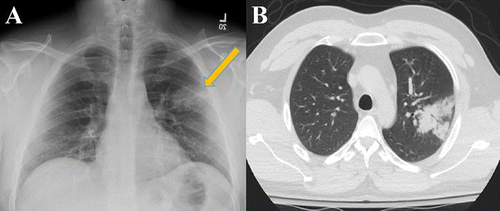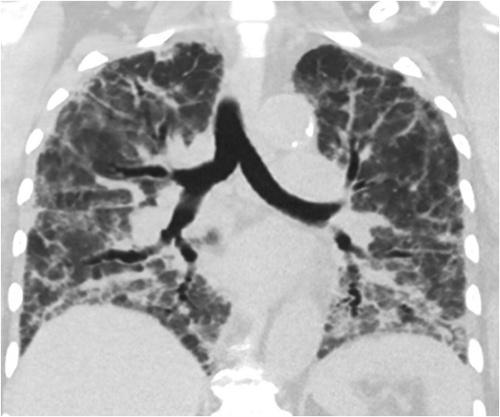Imaging COVID-19: Evaluating Available Options
Researchers from Mount Sinai examine and assess the imaging modalities used to evaluate patients positive for the virus.

Coronal chest CT of a 73-year-old-female with a history of hypertension and lupus and hospitalized for worsening respiratory status. Follow-up CT 30 days after initial symptoms demonstrated widespread reticulation with geographic regions of bronchiectasis and ground-glass opacity (GGO) and clear demarcations between spared lobules, consistent with an organizing pattern. Courtesy: Radiology: Cardiothoracic Imaging

Widespread consensus during the COVID-19 pandemic has been that the best way to diagnose a patient for viral infection is the RT-PCR test. However, the potentially low sensitivity of the test leaves a diagnostic and management void that imaging modalities have stepped in to fill -- the question is, however, which scan would be best?
“The [RT-PCR] test is highly specific, however, the sensitivity is reportedly as low as 60-to-70 percent due to insufficient viral load or failure of nucleic acid extraction,” wrote a team of investigators led by Ichan School of Medicine at Mount Sinai. “While chest radiography and computed tomography are not an official component of the diagnostic criteria for COVID-19 in the United States, CT, and less frequently [X-ray], have been used to support the diagnosis, determine severity, guide treatment, and assess treatment response.”
And, given reported clinical experience, they added, there could be a role for other imaging options, as well. In a review article published on June 1 in Radiology: Cardiothoracic Imaging, the team examined the efficacy of these imaging modalities and artificial intelligence in diagnosing and managing patients with viral infection. Based on chest images captured, they reported, the most common findings are multi-lobar, predominantly peripheral, and basilar ground-glass and mixed attenuation opacities. The team also examined non-chest complications.
Chest CT
More effective in identifying early-stage disease, chest CT has a sensitivity of 97 percent. Typical findings include multiple bilateral ground-glass opacities with or without consolidation, often with a rounded morphology and peripheral and lower-lung distribution. With this scan, providers can monitor lung abnormalities caused by COVID-19, pinpoint pulmonary thromboembolism, and identify concurrent diseases in patients with comorbidities.
Chest X-ray
Even though it has lower sensitivity than a chest CT or the RT-PCR – around 69 percent – the chest X-ray is still the frequently the initial imaging exam used with patients suspected of viral infection. When X-rays are positive, the most comon finding is hazy opacification, likely a radiographic correlation to ground-glass opacity seen on CT. It is important to note, however, that patients with a positive RT-PCR results can still have a negative chest X-ray, particularly in the early-disease stage.
MRI
This modality can identify incidental findings associated with the diseases in pulmonary parenchyma, and cardiac MRI might useful as myocarditis and cardiomyopathy have been described with COVID-19. But, the use for MRI with COVID-19 has not yet been fully determined or described.
PET/CT
There are few PET/CT reports associated with COVID-19. However, chest CT findings, such as ground-glass opacities and mixed attenuation, do correspond to FDG uptake. Reports also exist of incidental discovery of COVID-19 pneumonia on nuclear medicine exams. It is possible, as the pandemic continue to play out, the team said, that PET/CT could be used to track treatment response, predict recovery, and follow any long-term illness effects.
Chest Ultrasound
Some of the published literature has indicated these images have better sensitivity than what is available with a chest X-ray. In the emergency room, it has been an effective patient evaluation tool, pinpointing acute respiratory failure and COVID-19 pneumonia diagnosis. This modaliaty has also been helfpul in diagnosing blood clots and assessing thrombosis risks that are well documented in patients positive for the virus.
Echocardiography
Providers have increasingly used this option to assess COVID-19-positive patients for both peripheral thrombosis and deep vein thrombosis. The researchers also noted it could be particularly helpful in the intensive care unit, and it can also be used to evaluate COVID-19-related acute cardiac injury.
Artificial Intelligence
Overall, the team reported, AI has proven beneficial during the pandemic, largely due to its high-throughput analysis and imaging finding pattern recognition. These tools have been particularly helpful in triaging patients and in processing the high image volume that has accumulated in hospitals with significant COVID-19 case load.
Non-Chest Complications
Research has shown the impacts of COVID-19 extend beyond respiratory and pulmonary indications. The virus also increases the risk for venous thromboembolism, potentially leading to pulmonary embolism or stroke. Other findings have also been reported in the brain, heart, kidneys, and gastrointestinal tract. And, according to investigators, acute necrotizing encephalopathy, a condition believed to be relatd to the intracranial cytokine storm, can develop in some patients who have severe COVID-19 disease. But, further study is needed, they added, to fully determine the role of abdominal imaging associated with COVID-19.
Overall, the researchers explained, more imaging studies will be needed as patients continue to contract the virus. Radiologists must be aware of how the virus present in order to provide the highest level of care possible for each patient.
“We aim to enhance radiologists’ understanding of this disease in order to help guide diagnosis and management,” they said.
GE HealthCare Debuts AI-Powered Cardiac CT Device at ACC Conference
April 1st 2025Featuring enhanced low-dose image quality with motion-free images, the Revolution Vibe CT system reportedly facilitates improved diagnostic clarity for patients with conditions ranging from in-stent restenosis to atrial fibrillation.
New AI-Enabled Portable Ultrasound May Facilitate 50 Percent Reduction in Cardiac Imaging Scan Time
March 28th 2025Artificial intelligence (AI)-powered measurement capabilities provide key features with the Compact Ultrasound 5500CV device, which was unveiled at the American College of Cardiology (ACC) conference.